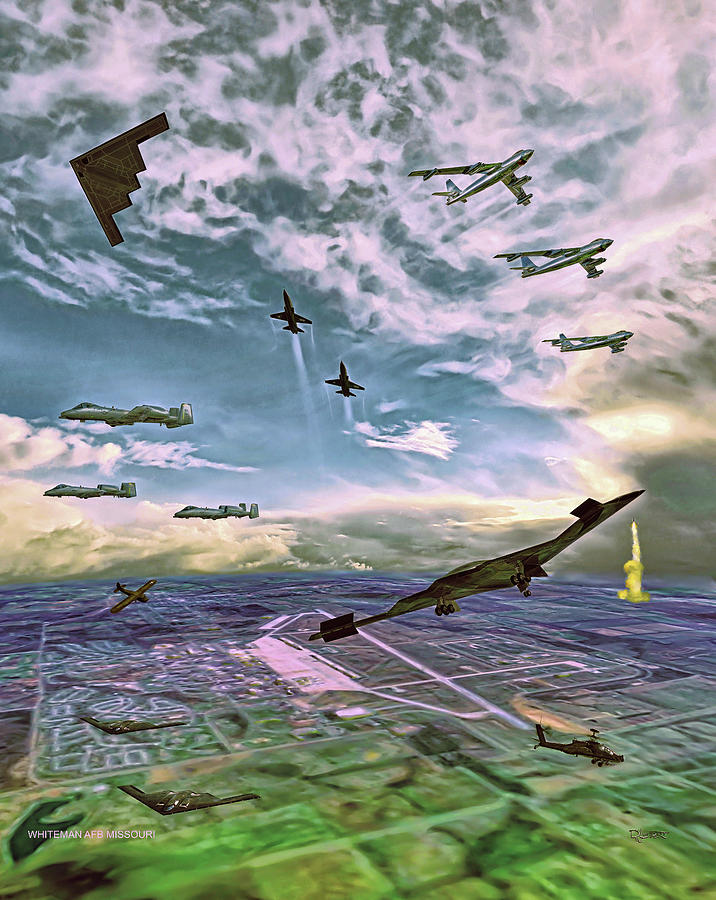
Whiteman Air Force Base

by David Luebbert
Title
Whiteman Air Force Base
Artist
David Luebbert
Medium
Painting - 2d/3d Digital Painting
Description
Watch the Youtube "Look-around" of this painting:
https://www.youtube.com/watch?v=e81ivyL2FB4
This is a 2D/3D image created by the artist honoring the Whiteman Air Force Base, located in Missouri State. Tools used to create this were ZBrush, Carrara, Keyshot, Paint Shop Pro to create the reference image and sketch, then painted by hand with Corel Painter 2016.
Read about the history of this Air Force base (from http://www.whiteman.af.mil/news/story.asp?id=123062505):
WHITEMAN AIR FORCE BASE, Mo. -- Whiteman Air Force Base is located in Johnson County, Missouri, 65 miles southeast of Kansas City. The base is two miles south of Knob Noster, just off U.S. Highway 50. Whiteman is about 10 miles east of Warrensburg and 20 miles west of Sedalia.
The base had it beginnings in 1942 during the U.S.' mobilization following the Japanese attack on Pearl Harbor. It was originally activated on Aug. 6, 1942, as Sedalia Glider Base.
In November 1942, the installation became Sedalia Army Air Field and was assigned to the 12th Troop Carrier Command of the Army Air Force. The field served as a training site for glider tactics and paratroopers.
Assigned aircraft included the Douglas C-46s, C-47s and the Waco CG-4A glider. During the massive demobilization in the mid 1940s, the base closed and most of the buildings were abandoned.
In August 1951, however, the base returned to life again and became a part of Strategic Air Command. SAC activated the 4224th Air Base Squadron to supervise the rehabilitation and construction of a new base, Sedalia AFB.
The 4224th continued its activities until Oct. 20, 1952, when it inactivated while turning over the base to the 340th Bombardment Wing. SAC scheduled the 340th to received the command's newest aircraft systems, the B-47 Stratojet and KC-97 tanker. Construction workers soon completed runway repairs and other projects in November 1953, paving the way for the arrival of the first B-47 in March 1954.
On Dec. 3, 1955, Sedalia AFB became Whiteman AFB in honor of 2nd Lt. George A. Whiteman. Lieutenant Whiteman, a native of Sedalia, was one of the first American airmen killed in World War II when the Japanese attacked Pearl Harbor, Hawaii, on Dec. 7, 1941.
During the attack of Bellows Air Field, Oahu, Lieutenant Whiteman managed to reach his fighter aircraft. While attempting to take off, enemy fighters attacked his plane. Sadly, Lieutenant Whiteman's P-40 crashed, fatally injuring the mid-Missouri native. By the time rescue teams reached the aircraft, Whiteman had died.
Construction on Whiteman continued throughout the 1950s. During this period, the Air Force built military family housing units as well as a base pool and gymnasium. However, a project on a much grander scale soon overshadowed this flurry of construction.
In June 1961, the Department of Defense chose Whiteman to host the fourth Minuteman ICBM wing. On Jan. 17, 1962, the firm of Morrison, Hardeman, Perrini, and Level received the prime contract for construction of hardened, underground launch facilities and 15 launch control centers. The project called for the excavation of 867,000 cubic yards of earth and rock.
The contractors used 168,000 yards of concrete, 25,355 tons of reinforcing steel and 15,120 tons of structural steel. In addition, the project called for the installation of a vast underground intersite cable network. If laid end to end in a straight line, this cable would stretch from Whiteman AFB to 100 miles beyond Los Angeles. Construction of the complex was officially completed in June 1964.
Before completion of the construction, SAC activated the 351st Strategic Missile Wing at Whiteman on Feb. 1, 1963. The 340th BMW gradually phased out operations during the same year with its remnants transferring to Bergstrom AFB, Texas, on Sept. 1, 1963.
After the mission change in 1963, life on Whiteman remained relatively stable throughout the 1960s and 1970s. Still, there were programs to continually update and improve the base's weapons systems.
Whiteman initially employed the Minuteman I weapons system until the mid-1960s when a force modernization program converted the Minuteman I to the Minuteman II. Throughout the ICBM's tenure at Whiteman, it went through a variety of modifications to keep it at the forefront of America's defense.
Several new buildings emerged from time to time as the base matured. However, with the beginning of the 1980s, a new construction phase started. New missile operations, maintenance and security police facilities as well as several enlisted dormitories marked the start of a new era.
Meanwhile, the base continued to lead the way. In the late 1980s, the 351st fielded the first female Minuteman missile crew, the first male and female Minuteman crew, and the first squadron commander to pull alert in the Minuteman system. Under the provisions of the Strategic Arms Reduction Treaty, the Minuteman II system is being inactivated.
Then came an announcement that would change Whiteman forever. On Jan. 5, 1987, Congressman Ike Skelton revealed that the first deployment of the B-2 Advanced Technology Bomber would be at Whiteman. Beginning in 1988, a massive construction wave that created new buildings designed for B-2 operations, maintenance and support activities swept over the base.
On July 1, 1990, the 100th Air Division activated at Whiteman and assumed host responsibilities for the base. Accordingly, the 351st Combat Support Group and the 351st Security Police Group, along with their assigned units and the squadrons under the deputy commander for resource management, inactivated at Whiteman. Concurrently, the Air Force activated equivalent squadrons bearing the 800th designator to replace the inactivated 351st units.
Several months after the air division's activation, on Sept. 30, 1990, the 509th Bomb Wing moved its headquarters to Whiteman albeit in an unmanned and non-operational state.
However, the 100th AD's tenure at Whiteman did not last long as SAC inactivated the unit on July 26, 1991. Similarly, Whiteman's host unit responsibilities reverted to the 351st.
During the next two years, Whiteman's building infrastructure continued to grow as the arrival date of the first B-2 drew nearer. Meanwhile, another change developed in the Air Force.
With the end of the Cold War, the Air Force disestablished Strategic Air Command, Tactical Air Command and Military Air Command on June 1, 1992. In their place arose two new organizations, one of which was Air Combat Command, the 509th's newer, higher headquarters.
On April 1, 1993, the 509th returned to operational status when people from Detachment 509, the base's B-2 overseers for the past two years, were formally assigned to the wing. Then, on July 1, 1993, the 509th accepted the host responsibilities for Whiteman from the 351st and a new era dawned for the base. Several days later, on July 20, 1993, flying operations returned to the base after a 30-year hiatus when the first permanently assigned T-38 landed at Whiteman.
Then, on Dec. 17, 1993, the event that Whiteman had long awaited finally arrived. On that day, at approximately 2 p.m., a dark jet bomber swooped from the sky and landed on the Whiteman runway. Amid much fanfare, the first operational B-2, The Spirit of Missouri, had arrived. Less than a week later, on Dec. 22, 1993, Whiteman again made history as it generated the first B-2 sortie from the base.
On June 12, 1994, the base welcomed the 442nd Fighter Wing. The 442nd, an Air Force Reserve unit previously assigned to Richards-Gebaur AFB, Mo., transferred to Whiteman after the closure of that installation.
Yet, the 442nd was not really a newcomer to the base. On Sept. 1, 1943, the then-called 442nd Troop Carrier Group activated at Sedalia Army Air Field. It subsequently remained at the base until December 1943.
In 1995 the base also lost one of its long-time resident units. On July 31, 1995, the 351st Missile Wing officially inactivated, ending its 33-year association with Whiteman AFB.
Throughout its history, the base has always been at the forefront of national defense. With the arrival of the first B-2 and the subsequent assignment of others, the future for the installation does, indeed, look bright for many years to come.
On Feb. 1, 2010, the 509th Bomb Wing at Whiteman Air Force Base became part of the newly created Air Force Global Strike.
Revised version, July 4, 2016.
Visit the LouBear Pixels gallery, loubear.pixels.com, for many more forms of printing... puzzles, lifestyle, stationery, beach, coffee mugs, apparel.
David has always been good at sketching exactly what he sees and as faithfully as possible, that is, if he can see it first, this has become his ADVENTURE, once he helps that subject become reality, he finds something else he has not created before, something that he yearns to paint. For David, style and technique are secondary in importance to the subject, making them transparent, so the subject can form completely as it should without him interjecting his own personality. The joy of creating, the love of the Creator and appreciation of Creation itself is what drives this whole process, more than anything else. Starting with an idea, a concept, he starts sketching, imagining, studying, creating the subject and composition, then develops the idea into his painting. The adventure of creation is not about David, it is about letting the creation come into existence, and his sole goal as an artist is to experience the joy of creating something fun or enjoyable, and to be able to share those creation experiences with all others.
Uploaded
November 11th, 2015
Embed
Share























































